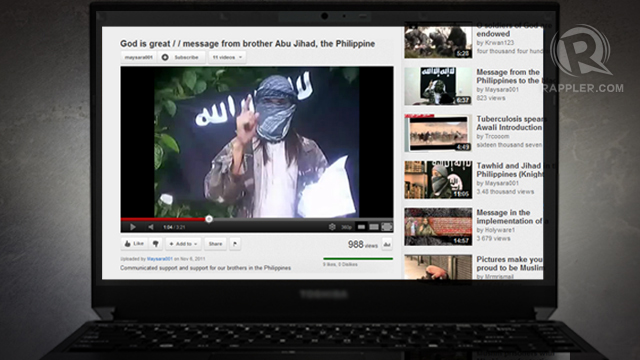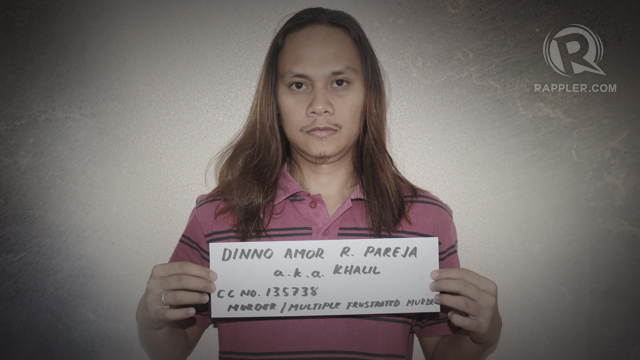SUMMARY
This is AI generated summarization, which may have errors. For context, always refer to the full article.

MANILA, Philippines – On Nov 6, 2011, a Filipino man with long hair uploaded a three-minute, 20-second video on YouTube, the world’s second largest search engine. It was a video of himself, wearing a camouflage jacket and a mask covering his face and head. He was speaking in Arabic and asking Muslims around the world to support and contribute to the jihad in the Philippines.
Identified as Commander Abu Jihad Khalil al-Rahman al-Luzoni, the man on the video called on Muslims to unite and help their brethren, saying there was “no way to restore the Islamic Caliphate and the glory of the religion but through jihad.”
It was the first of its kind for the Philippines, triggering a wave of videos, letters and audio messages from Filipino jihadists which were promoted on al-Qaeda linked sites and jihadist websites like Shumukh al-Islam and Ansar al-Mujahideen English Forum (AMEF).
They declared allegiance to al-Qaeda online and on social networks.

Intelligence sources from 3 different countries told Rappler that Abu Jihad Khalil, the man with the long hair, is 31-year old Khalil Pareja, a Christian convert to Islam who took over the leadership of the Rajah Solaiman Movement (RSM) in 2005.
RSM worked closely with the Abu Sayyaf (ASG) and Jemaah Islamiyah (JI), al-Qaeda’s arm in Southeast Asia. Their alliance carried out at least two attacks: the Superferry bombing in 2004, one of the world’s worst maritime terrorist attacks and the second most lethal in Southeast Asia since the 2002 Bali bombing; and the Valentine’s Day bombings in 2005 – two near-simultaneous explosions in General Santos City and Davao City, followed an hour later by an explosion on a bus in Makati.
A Philippine intelligence report obtained and verified by Rappler said that Pareja not only posted jihadi materials on YouTube, he was also active on Facebook – a case study of how one man can connect jihadists and terrorists from multiple countries through social media.
About a month before he posted his YouTube video, Pareja told authorities he joined the Arabic Student Forum on Facebook. Several of the members asked him if he knew Abu Jihad, but he said he was cautious about security. Then he received a private message (PM) from a man who introduced himself as Gerald. They became friends and started chatting regularly.
Over time, Gerald told Pareja he was a member of al-Shabaab, Islamist militants who control much of southern Somalia. The relationship between al-Shabaab and al-Qaeda dates back to the 1990’s.
Most lethal affiliate
It seems Osama bin Laden’s death in 2011 helped pave the way for closer ties between the two groups. In February 2012, al-Shabaab’s leadership pledged allegiance to Ayman al-Zawahiri, who replaced bin Laden as al-Qaeda’s new leader. This was announced on a video uploaded on the Internet by al-Qaeda’s media arm.
This agreement showed that despite bin Laden’s death, al-Qaeda continues to grow.
Pareja told Gerald he was Abu Jihad. Gerald invited him to go to Yemen to join the jihad led by al-Qaeda’s Yemeni affiliate, al-Qaeda in the Arabian Peninsula or AQAP. Counterterrorism analysts characterize AQAP as the “most active and lethal Qaeda affiliate, intent on striking at both the US homeland and regional targets.”
In mid-2012, US authorities used a CIA sting operation to foil an AQAP plot to bomb US-bound airplanes with explosives hidden in the bodies of terrorists. Experts said AQAP’s master bomb-maker, Ibrahim al-Asiri, had been working on body bombs, explosives surgically implanted in either the stomach or rectal cavity.
AQAP was also involved in other foiled plots against US targets: the “underwear bomb” used in an attempt to take down Northwest Flight 253 in 2009 and the “printer bombs” in the failed cargo bomb plot in 2010.
One of its leaders, American Anwar al-Awlaki was a “master in the use of the Internet.” And although he was killed by the US in 2011, his messages continue to resonate and win recruits online.
Awlaki was prolific on YouTube; among those he influenced were the London attackers who carried out Britain’s 9/11 on July 7, 2005 (commonly referred to as 7/7). He had his own website (now taken down by authorities) which attracted extremists and the head of AQAP, bin Laden’s secretary, Nasir al-Wuhaishi. He consulted bin Laden and appointed Awlaki the head of AQAP’s external operations, in charge of terrorist attacks outside Yemen and Saudi Arabia.
Awlaki was a cyberworld superstar because he was an eloquent speaker, and he understood the virtual world. His ideas remain with AQAP, which continues his online recruitment efforts.
Pareja said Gerald told him AQAP “had established an Islamic state in the province of Abian in Yemen” and had already recruited “Filipinos studying from the Islamic schools in Saudi Arabia, Egypt and Sudan.” He asked Pareja to join the jihad in Yemen and help lead the Filipinos. He said they would stay in Yemen for 10 years.
After 5 years, they could choose to return to the Philippines, at which point AQAP “would provide them funds to continue jihad to establish an Islamic Caliphate.” Gerald offered to pay for Pareja’s travel expenses to Yemen. Pareja accepted the offer and was scheduled to travel between April and June of 2012.
He never made it because Filipino authorities arrested him on March 1.
Today, the 11th anniversary of the 9/11 attacks, al-Qaeda has been degraded but it has evolved and grown into a social movement. It continues to spread its virulent ideology – this time in the virtual world and on social media.
This is the battleground of the future. – Rappler.com
(Editor’s note: This is the first part of a Rappler series and includes excerpts of Maria Ressa’s upcoming book, “10 Days, 10 Years: From Bin Laden to Facebook.” Set to be published in October, it includes research done for the International Center for Political Violence & Terrorism Research in Singapore and the Naval Postgraduate School’s CORE Lab in the US.)
Add a comment
How does this make you feel?
There are no comments yet. Add your comment to start the conversation.